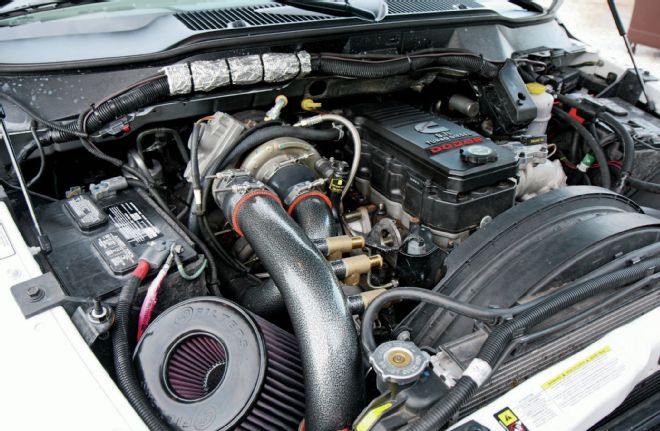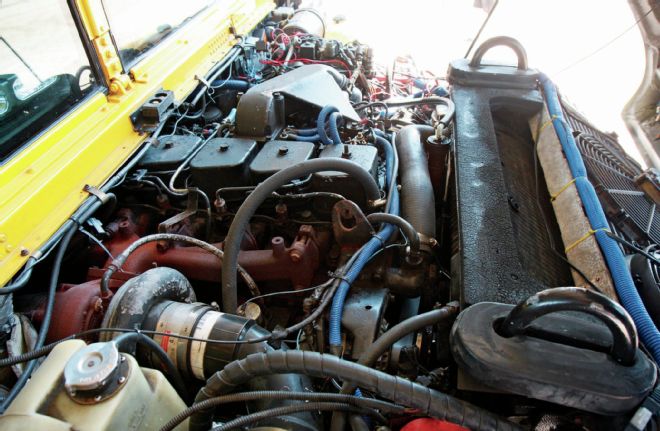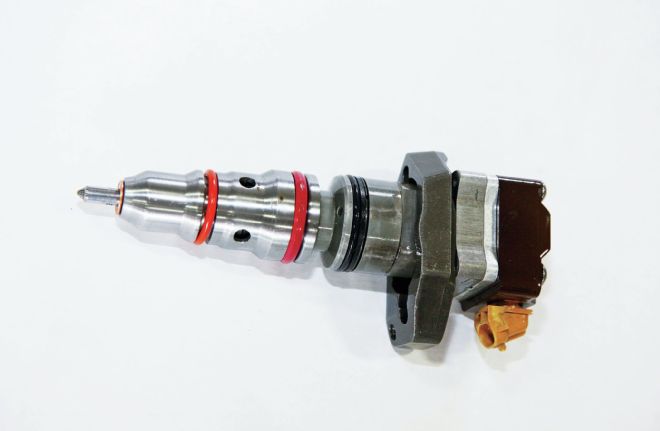Question:I recently purchased a 2012 Ram 2500 with a 6.7L Cummins and want to make it stronger, faster, better...you get the idea. I am not new to the mechanical world, as I am an automotive technician, but I am new to the diesel world, and this one is my first. I was wondering if you guys know of a tried-and-true setup on the 6.7L that can get me to 700 rwhp but remain reliable, as this is my daily driver. It’s not going to be hot-rodded, but it does pull my work trailers every so often. Now, I understand that as power increases longevity will usually decrease, but what kind of things can I do to get me to this power level? And which parts will need to be replaced to increase longevity? My point is, I don’t want to be dead in the water at 100,000 miles. I also understand that parts can be quite pricey, but for the sake of this letter let’s assume price is not an issue. I would also like to keep the variable-geometry turbo in a compound setup, as opposed to a large single turbo. I have already installed an S&B intake, 5-inch Flo-Pro exhaust, and H&S Mini Maxx, and vented the crankcase to the atmosphere as opposed to the intake tract. So what can you tell me?
Dennis Diaz
via email
 | While the factory variable-geometry Holset found on 6.7L Cummins mills provides incredible spool up in a compound-turbo arrangement, its life is limited in such systems due to excessive drive pressure.
Answer: Having a power goal in mind is the first step in any build, so good job on that front, Dennis. With no budget holding us back, here’s what we would do for the ultimate, 700hp truck that can tow without issue. A set of balanced injectors equipped with 60-percent-over nozzles will be on order to get to 700 hp but will require a CP3 upgrade. For longevity, we would opt for dual CP3s over a single stroker pump. With two CP3s in the mix, the pumps can share the workload of creating pressure. Supplying the CP3s all the fuel they need would be left to a Titanium Series fuel system from FASS. The company’s Titanium Series comes with the same lift pump motor used in its Class 8 systems, so you know it’s proven to last hundreds of thousands of miles.
For airflow, we would install a compound turbocharger system -- and ditch the factory VGT Holset. We’d get rid of the factory turbo for reliability reasons. In a compound arrangement, the factory 58/65/.65 unit would see a lot of drive pressure, and more than likely wouldn’t survive very long. We’d opt for a proven S300 charger from BorgWarner over the stocker, and a BorgWarner S400 as the atmospheric unit. Due to the 6.7L Cummins’ displacement, an S364 over S480 would be just as driveable as an S362 over S475 setup is on a 5.9L. Spool up would be quick, throttle response would be crisp, and the setup would flow enough air for 1,000 hp if you ever wanted to make more power down the road.
For reliability -- and because the engine would likely see in excess of 60 psi of boost -- we would install a set of ARP’s Custom Age 625 head studs. Then, we would invest in a significantly upgraded 68RFE six-speed automatic transmission. We would recommend either a Stage 4 68RFE from ATS, or a M3GA Competition 68RFE from Sun Coast to get the slushbox to hold up, long term, under 700 hp and towing duty. And finally, we’d find a calibrator familiar with H&S MCC software, so all your modifications can be tied together to work in unison, maximizing horsepower, fuel economy, and powertrain longevity.
| While the factory variable-geometry Holset found on 6.7L Cummins mills provides incredible spool up in a compound-turbo arrangement, its life is limited in such systems due to excessive drive pressure.
Answer: Having a power goal in mind is the first step in any build, so good job on that front, Dennis. With no budget holding us back, here’s what we would do for the ultimate, 700hp truck that can tow without issue. A set of balanced injectors equipped with 60-percent-over nozzles will be on order to get to 700 hp but will require a CP3 upgrade. For longevity, we would opt for dual CP3s over a single stroker pump. With two CP3s in the mix, the pumps can share the workload of creating pressure. Supplying the CP3s all the fuel they need would be left to a Titanium Series fuel system from FASS. The company’s Titanium Series comes with the same lift pump motor used in its Class 8 systems, so you know it’s proven to last hundreds of thousands of miles.
For airflow, we would install a compound turbocharger system -- and ditch the factory VGT Holset. We’d get rid of the factory turbo for reliability reasons. In a compound arrangement, the factory 58/65/.65 unit would see a lot of drive pressure, and more than likely wouldn’t survive very long. We’d opt for a proven S300 charger from BorgWarner over the stocker, and a BorgWarner S400 as the atmospheric unit. Due to the 6.7L Cummins’ displacement, an S364 over S480 would be just as driveable as an S362 over S475 setup is on a 5.9L. Spool up would be quick, throttle response would be crisp, and the setup would flow enough air for 1,000 hp if you ever wanted to make more power down the road.
For reliability -- and because the engine would likely see in excess of 60 psi of boost -- we would install a set of ARP’s Custom Age 625 head studs. Then, we would invest in a significantly upgraded 68RFE six-speed automatic transmission. We would recommend either a Stage 4 68RFE from ATS, or a M3GA Competition 68RFE from Sun Coast to get the slushbox to hold up, long term, under 700 hp and towing duty. And finally, we’d find a calibrator familiar with H&S MCC software, so all your modifications can be tied together to work in unison, maximizing horsepower, fuel economy, and powertrain longevity.
Question: I just read your online article “How To Pass A Smog Test,” and I could use some guidance on a diesel engine swap. I have a stock 1987 Jeep Grand Wagoneer. The performance and specifications on the 1987 Grand Wagoneer are pretty weak: AMC 360ci V-8, producing 144 hp and 280 lb-ft of torque (11 mpg city, 13 mpg highway). I read the CARB Smog Check Reference Guide, Appendix E Engine Change Guidelines (Page 73-74), and I believe I can do an engine swap.
My question is: How do I determine which smog parts were on an ’87 ½-ton diesel? I would like to use 2014 diesel technology, but I don’t want to cause waves with the DMV. Do you know which types of ½-ton diesels were available in 1987, and what the smog requirement was?Gene
via email
 | We have heard of gas-to-diesel swaps passing inspection and the owner later repowering the vehicle with a different diesel engine (say, passing inspection with a 6.5L GM under the hood, then swapping in a 5.9L or 4BT Cummins—and “forgetting” to tell Big Brother about it). But, those may just be stories… We wouldn’t advise going that route if you want to drive a legitimate swap vehicle on public roads in California.
Answer: You’re right. You can most definitely perform a gas-to-diesel swap on your Wagoneer in California, but there are certain criteria you’ll have to meet, and we would definitely install an older diesel engine unless you want to be subjected to smog testing. First, the engine you choose to install must be from the same class of vehicle as your Wagoneer (think ½-ton pickup). Engines like the 6.2L or 6.5L GM IDI V-8 would be viable and usable candidates. If you’re after a 6BT Cummins, Duramax, or Power Stroke engine swap, unfortunately the swap vehicle will have to be based on a ¾-ton or 1-ton chassis.
Second, and just to provide more clarity on what we touched on above, pre-’98 diesels are currently exempt from smog testing in the Golden State. This means as long as you install an engine that was produced prior to 1998, you won’t be subjected to biannual smog tests once it’s up and running.
To know for sure if you’ll be 100 percent legal, we’d schedule an appointment with a smog referee (this can be done through your local California Highway Patrol office). Relax—the refs don’t bite. Instead, they’ll give you the lowdown on what it will take to get you up and running, legally. After all, the vehicle will eventually end up in front of a referee in order to be tested, verified, and titled anyway, so it’s a great place to start (before you start spending time and money on your swap).
| We have heard of gas-to-diesel swaps passing inspection and the owner later repowering the vehicle with a different diesel engine (say, passing inspection with a 6.5L GM under the hood, then swapping in a 5.9L or 4BT Cummins—and “forgetting” to tell Big Brother about it). But, those may just be stories… We wouldn’t advise going that route if you want to drive a legitimate swap vehicle on public roads in California.
Answer: You’re right. You can most definitely perform a gas-to-diesel swap on your Wagoneer in California, but there are certain criteria you’ll have to meet, and we would definitely install an older diesel engine unless you want to be subjected to smog testing. First, the engine you choose to install must be from the same class of vehicle as your Wagoneer (think ½-ton pickup). Engines like the 6.2L or 6.5L GM IDI V-8 would be viable and usable candidates. If you’re after a 6BT Cummins, Duramax, or Power Stroke engine swap, unfortunately the swap vehicle will have to be based on a ¾-ton or 1-ton chassis.
Second, and just to provide more clarity on what we touched on above, pre-’98 diesels are currently exempt from smog testing in the Golden State. This means as long as you install an engine that was produced prior to 1998, you won’t be subjected to biannual smog tests once it’s up and running.
To know for sure if you’ll be 100 percent legal, we’d schedule an appointment with a smog referee (this can be done through your local California Highway Patrol office). Relax—the refs don’t bite. Instead, they’ll give you the lowdown on what it will take to get you up and running, legally. After all, the vehicle will eventually end up in front of a referee in order to be tested, verified, and titled anyway, so it’s a great place to start (before you start spending time and money on your swap).
Question:I always enjoy your 7.3L articles in Diesel Power. My question is, where do you get hybrid injectors? I haven’t seen them advertised. Also, what is needed for the programming? I’m fairly new to the diesel scene and am trying to learn as much as I can. I have a ’97 F-350. I really like the old-body-style Fords. I would like to have 450 hp and am currently rebuilding an engine. It is bored 0.010 inch over, and I have several of the same parts you have in yours. Any advice is welcomed. Thank you for your time.
James Waller
via email
 | Hybrid injectors for the 7.3L Power Stroke got their start in the form of fitting an A-code injector with a single-shot, BD-code plunger and barrel from an I530E International engine. This increases the bore of the injector, and the retention of the A-code’s stock 16mm intensifier piston allows the injector to use less oil to actuate than a BD-code injector would, hence only one high-pressure oil pump is needed to make 450 to 700 hp.
Also, while the engine gets reassembled (wallet-permitting), we would add head studs, stiffer valvesprings, and pushrods. It’s good insurance. In addition, you’ll want more high-pressure oil volume available, so at least upgrade to a healthy remanufactured or new Super Duty high-pressure oil pump (intended for a ’99½ to ’03 engine), or an Adrenaline (from DieselSite). And, don’t forget to upgrade to an electric fuel supply system if you haven’t already.
This was our plan of attack for our 1997 F-350 several years ago, prior to its current 550-plus-horespower status: Stage 3 238/80 hybrids from Unlimited Diesel Performance, Gearhead Automotive Performance custom tuning on a TS Performance six-position chip, new OE head gaskets and ARP head studs, and a John Wood Automotive Street Performance E4OD transmission.
The above combo netted us 436 hp and 818 lb-ft of torque on a chassis dyno, but 450 hp could’ve been possible with a higher flowing turbo and larger intercooler.
| Hybrid injectors for the 7.3L Power Stroke got their start in the form of fitting an A-code injector with a single-shot, BD-code plunger and barrel from an I530E International engine. This increases the bore of the injector, and the retention of the A-code’s stock 16mm intensifier piston allows the injector to use less oil to actuate than a BD-code injector would, hence only one high-pressure oil pump is needed to make 450 to 700 hp.
Also, while the engine gets reassembled (wallet-permitting), we would add head studs, stiffer valvesprings, and pushrods. It’s good insurance. In addition, you’ll want more high-pressure oil volume available, so at least upgrade to a healthy remanufactured or new Super Duty high-pressure oil pump (intended for a ’99½ to ’03 engine), or an Adrenaline (from DieselSite). And, don’t forget to upgrade to an electric fuel supply system if you haven’t already.
This was our plan of attack for our 1997 F-350 several years ago, prior to its current 550-plus-horespower status: Stage 3 238/80 hybrids from Unlimited Diesel Performance, Gearhead Automotive Performance custom tuning on a TS Performance six-position chip, new OE head gaskets and ARP head studs, and a John Wood Automotive Street Performance E4OD transmission.
The above combo netted us 436 hp and 818 lb-ft of torque on a chassis dyno, but 450 hp could’ve been possible with a higher flowing turbo and larger intercooler.